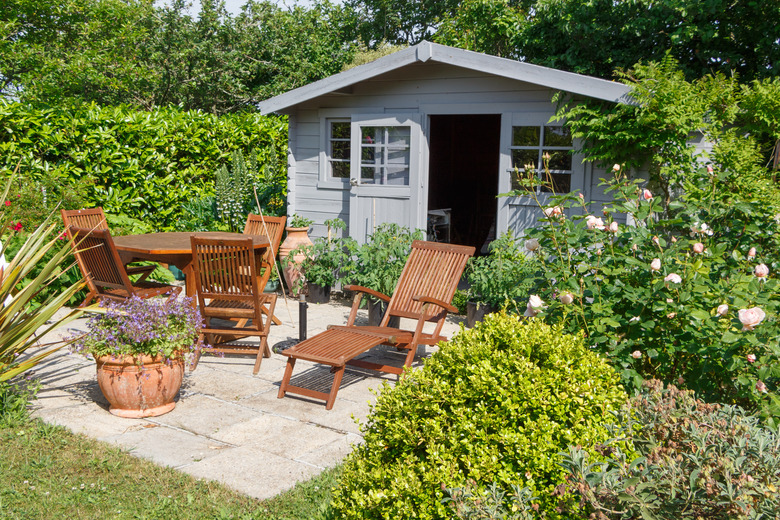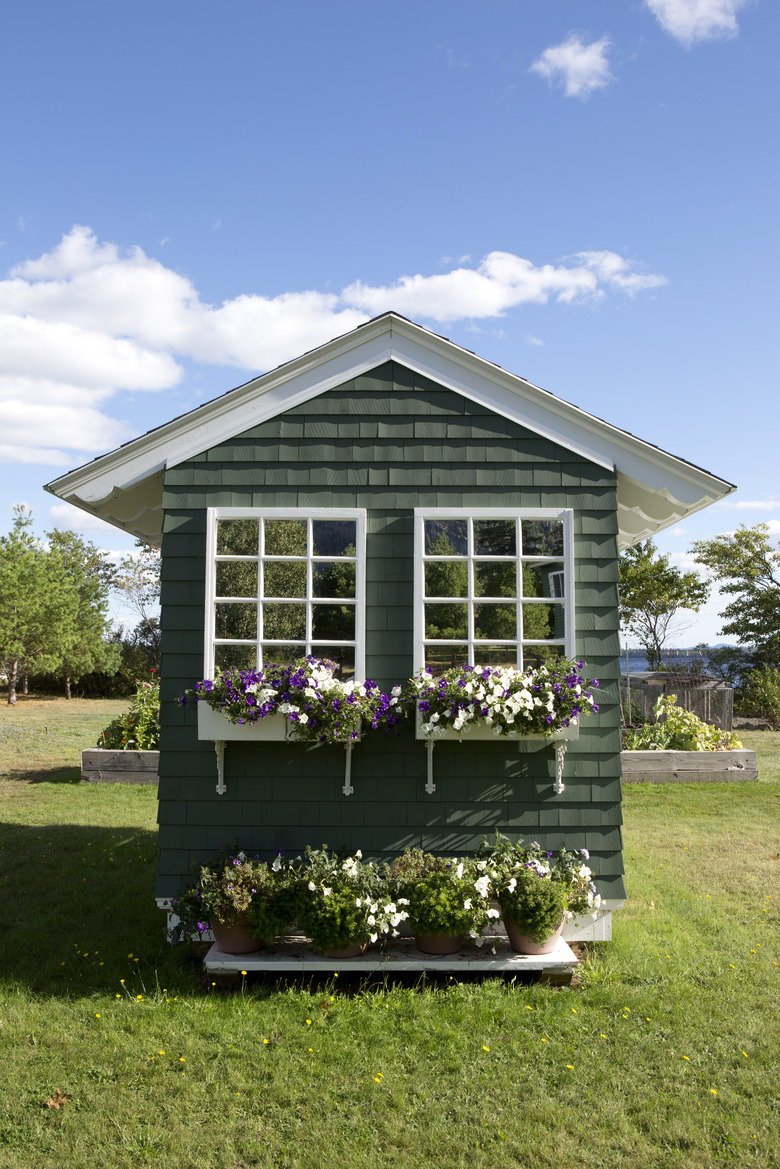Choosing Materials For A Garden Storage Shed
We may receive a commission on purchases made from links.
For many homeowners, the primary motivation for having a garden shed is to store garden equipment, but that's far from the only reason you might want one. If built for it, a storage shed can double as a workshop, a playhouse, an office and even a retreat space where you can commune with your roses. Your choice of shed materials will depend on how you plan to use the shed, your budget and whether or not you prefer to assemble a prefabricated shed kit or construct one from scratch as a DIY project.
Siding materials for a shed building must be rigid and waterproof, and until someone finds a way to turn bamboo into a siding material (they're probably working on it right now), the four choices are metal, plastic (vinyl or resin), fabric and wood, and if you plan to DIY your own shed, you'll more than likely want wood. Besides providing extra space for storage and other purposes, wood sheds add an aesthetic element to your garden and beautify the landscape, and they stay cooler in summer and warmer in winter. Building a wood shed is more than a weekend home improvement project, though, and you may prefer to simply assemble one, in which case, you have your choice of the four shed materials.
If you decide to build a new backyard shed from scratch, you'll need building materials not just for the sides but for the frame, floor and roof as well as the door and windows and incidentals such as trim to make the shed beautiful and watertight. Keep in mind that depending on the size of your DIY shed and where you live, you might need a building permit or approval from your homeowners' association to erect one — even a prefab one — so be sure to check before you buy anything.
A Quick and Easy Garden Shed
A Quick and Easy Garden Shed
If the main purpose of your new shed is for outdoor storage and you're looking for a relatively small one that you can plunk next to the house or in an out-of-the-way corner of the garden, your best bet is probably a prefab wood, metal, plastic or fabric one. Most of these types of sheds are available in extra-large sizes with a generous floor space of 300 square feet or more, but if you want a wood shed that size, you may be better off building your own.
An 8 x 10-foot metal storage shed made from galvanized steel or aluminum can be had for less than $400, although you can pay more if you want a pretty one, and it's your choice whether to buy one with a floor or build your own. A plastic shed of comparable size is likely to cost $100 to $200 more, while a fabric shed consisting of a metal frame and durable polyethylene, canvas or polyester covering will cost $100 to $200 less. A wood shed is the most expensive prefab one, costing at least twice as much as any other type. Each material has its pros and cons:
- Metal sheds are lightweight, but they can be difficult to assemble, and metal is among the least durable shed materials. No matter how the metal is finished, it's prone to rust and corrosion, and when small pits and holes develop and the shed begins to leak, you have to replace it.
- Plastic sheds are virtually indestructible, and they are easy to assemble, often requiring little more than snapping pre-molded pieces together. They have more durability than even wood sheds and are completely watertight, but they don't provide much shelter for people looking for a retreat space or a workshop.
- Fabric sheds are purely temporary solutions, but they are practical if you're looking for quick storage for your garden tools or vehicles, which can be particularly helpful for renters. They are the cheapest and easiest to assemble of the prefab sheds, but they aren't completely waterproof, and the fabric can tear in a strong wind.
- Wood sheds are sturdy and attractive, and assembling one may not be a DIY job, although you can often purchase one preassembled and ready to drop onto a premade foundation. Wood deteriorates if it is not maintained. Periodic painting or staining, repairs and parts replacement are required to get the most longevity from a wood shed.
Designing a DIY Storage Shed
Designing a DIY Storage Shed
If you want a storage shed that will fulfill all your extra-space needs and look beautiful, you might have to make it yourself, and if you decide to do that, it's best to use wood. You'll find many wood shed plans online complete with step-by-step instructions for how to build a shed, and because a shed doesn't require plumbing, drywall or insulation — and electricity is optional — it's a less complex DIY project than a dwelling unit, so your carpentry skills don't necessarily have to be super advanced.
Besides windows, doors and extras like lofts, workbenches and cabinets, a shed has five main components. They are the foundation, the floor, the framing, the siding and the roof, and though materials for floors and framing are standard, you have a choice of materials for the foundation, the siding and the roofing.
There are roughly a dozen different shed foundation designs, ranging from a gravel pad or timber skids set on gravel to buried posts or concrete footers supporting beams. Your shed should have a floor to make sure everything inside it stays dry, and that's usually made from lumber and plywood. Siding can be wood shingles, wood planks or some other material, such as fiber cement, vinyl or aluminum, but the easiest wood siding option is probably T1-11. For framing, you'll use dimensioned fir or pine lumber, such as 2x4s and 4x4s, and for the roof, you'll use asphalt shingles, asphalt roll roofing, metal or corrugated plastic.
All these materials are as suitable for a small shed as a large one, so you'll be making your choices based primarily on cost and appearance. Framing and flooring materials are fairly standard, and you'll have the most freedom of choice in the roofing and siding materials, exterior trim, windows and doors. You'll also have to decide on a roof design. While a peaked roof on a gable shed is decorative, it's more difficult to build than a standard shed roof, which slopes in only one direction. If you're attaching a storage shed to your house, a standard shed roof is the type of roof you want.
Shed Plans for an 8x10 Garden Shed
Shed Plans for an 8x10 Garden Shed
Building a wood garden shed may not be a weekend DIY project, but if you keep the plans simple, you may be able to do the job in two or three weekends or in a week of solid effort. To that end, place it on a skid foundation (a portable, wooden foundation), which is one of the easiest to make and requires little digging, and use T1-11 siding, which requires no sheathing underneath. Construct a shed roof and cover it with asphalt shingles to provide a little extra insulation while keeping your costs low.
Any wood in contact with the ground or close to it should be pressure treated to prevent rot, and this includes the skids, foundation framing and the plywood you use for the floor. Framing materials can be standard construction lumber, and while the siding and exterior trim don't need to be pressure treated, they must be weather-resistant (which most are, pretty much by definition). Properly sealed T1-11 holds up well to sun and rain, especially if you stain or paint it, which you'll probably want to do, given that it's fairly unattractive in its unfinished state. Rough-sawn cedar and redwood are both good choices for trim to complete the rustic theme established by T1-11.
Now that you've made your choice of materials, the only thing left to do before going to the lumber yard is to figure out how much of each material you need to complete the shed. To that end, a diagram of the finished shed is helpful, and while you don't need to draw a blueprint, you should make a scale diagram on graph paper so you can see the dimensions at a glance. Make a top view and a side view.
Shed Materials for an 8x10 Garden Shed
Shed Materials for an 8x10 Garden Shed
Once you've made your shed diagram, your materials list for your freestanding 8x10 garden shed with a shed-style roof will contain the following items:
Foundation:
- Three or four lengths of pressure-treated 8x8 timber. These usually come in 12-foot lengths, so to avoid waste, cut three of them to 10 feet and place them along the length of the shed rather than the width. If you can find 8 footers, you can place four of them along the width with no waste.
- 3/4-inch angular drain rock to put under the skids. If you buy this in bags, each bag contains roughly 1/2 cubic foot of rock. You'll need from 12 to 14 bags.
Floor:
- 36 feet of pressure-treated 4x4 lumber. This comes in 8- and 10-foot lengths. Purchase two 8 footers and two 10 footers.
- Four galvanized steel angle brackets for securing the 4x4s together to form the floor perimeter.
- Seven pressure-treated 2x4s for floor joists.
- Fourteen 2x4 galvanized steel joist hangers.
- 1 1/2-inch joist hanger nails.
- Three 4x8 sheets of pressure-treated 3/4-inch plywood.
- 1 5/8-inch exterior screws to secure the plywood to the joists.
Framing:
- Thirty-six 2x4 studs to frame the walls (standard 8-foot length); 72 feet of 2x4 lumber for the top and bottom wall plates and 120 feet of 2x4 lumber for the roof, assuming a 6-inch roof overhang. If you plan to frame in windows, you'll need about 10 percent more 2x4 lumber.
- 3-inch wood screws to assemble the framing.
- Sixteen hurricane ties to attach the roof rafters to the wall plates.
Siding:
- One 100-foot roll of house wrap.
- 3/8-inch staples.
- Ten 4x8 sheets of T1-11 siding. This can be grooved or ungrooved — your choice. Fasten the siding to the studs with 1 5/8-inch exterior screws.
- 170 feet of 1 x 3-inch rough-sawn or smooth cedar or redwood trim. You can also fasten these with 1 5/8-inch exterior screws, or you can use 2-inch galvanized finish nails.
Roof:
- Four sheets of 1/2-inch CDX plywood. Secure these with 1 5/8-inch exterior screws.
- 100 square feet of tar paper (one 72-foot roll). Secure this to the decking with 3/8-inch staples.
- 20 feet of drip edge flashing.
- 1-inch roofing nails.
- 100 square feet of asphalt shingles (three bundles).
You'll also want to purchase a door for the shed. The style and material is up to you. Windows are optional but highly recommended if you plan to spend any time in the shed. If you want to paint or stain the shed, which is also highly recommended, especially in places with a lot of moisture in the air, you'll need 2 to 4 gallons of exterior paint or stain depending on coverage and an extra gallon of paint or stain for the trim if you decide to make it a different color.
References
- Zacs Garden: The Pros and Cons of Fabric Sheds
- ShelterLogic: 4 Things to Consider When Choosing a Backyard Storage Shed
- Secrets-of-shed-building.com: The Garden Shed Guide – Help With Choosing The Best Shed Style And Material of Construction
- Lifetime: Which Shed Material Is Best for You
- My Outdoor Plans: 8 x 10 Shed Plans

